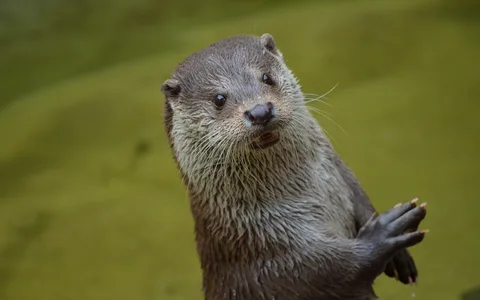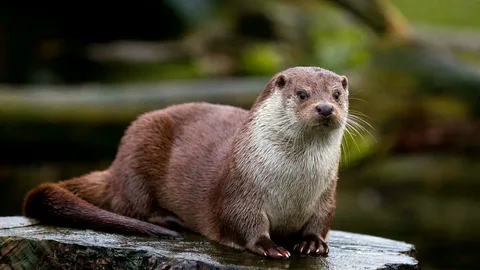The Eurasian Otter is an animal that swims very well, dives like a seal, and plays like a child. Eurasian Otter — An intelligent and beautiful water-dwelling animal.
Its scientific name is Lutra lutra. This Eurasian otter is not only spectacular, it is very important for the natural environment. It helps to keep rivers, streams and reservoirs healthy and clean.
Although the species was endangered due to contamination and predation, they are now being seen again in many places. And we can all contribute to this.
Let’s get to know this wonderful animal called the Eurasian Otter.
Where are Eurasian Otters found?
Eurasian Otters are found in more than 70 countries. especially-
Europe: Ireland, England, France, Italy, Norway
Asia: Russia, China, India (Jammu, Kerala, Assam etc.)
North Africa: Where there are freshwater streams
These otters like to be solitary most of the time, and try to hide away from humans. That’s why, it takes a lot of luck to spot an otter.
Habitat: What Kind of Home Does It Need?
Eurasian otters are very picky about where they live. They need:
- Clean freshwater (without pollution)
- Plenty of fish
- Quiet, natural surroundings
- Places to hide and rest, like reeds, fallen logs, or holes in riverbanks
Their homes, called holts, are usually hidden from view. Otters will dig a hole or use natural spaces like:
- Tree roots
- Hollow logs
- Caves near rivers
- Old burrows of other animals
Holts are lined with dry grass, leaves, and moss to keep them warm.
During the winter, when the rivers freeze, otters may dig holes through the ice to keep swimming and hunting.

What Do Eurasian Otters Eat?
The Eurasian Otter is a carnivore, which means it eats only meat. Its main food is fish, but that’s not all. Here’s a list of what they eat:
- Fish (trout, salmon, eels, perch)
- Frogs and toads
- Crabs and crayfish
- Water snails and worms
- Small birds and their eggs
- Small mammals like water rats
Otters hunt mostly at night (they are nocturnal), using their excellent hearing, whiskers, and eyesight to find prey underwater.
They are patient hunters and can chase fish with incredible speed and skill.
How Do They Swim So Well?
Eurasian Otters are built for water. Eurasian Otters body is long and flexible like a snake, but strong like a cat.
Swimming features:
- Webbed feet: Help them paddle through water like ducks
- Strong tail: Used like a rudder to steer
- Nostrils and ears: Close when they dive, so water doesn’t get in
- Thick fur: Keeps them dry and warm even in freezing rivers
Otters are also very graceful underwater. They can:
- Stay underwater for up to 4 minutes
- Dive up to 15 meters deep
- Swim at speeds of 7 to 10 kilometers per hour
They are playful, too. Sometimes, you might see them sliding down muddy slopes or rolling in the snow.
Life of a Baby Otter
Eurasian Otter babies are called cubs or pups.
How many babies are born?
- Usually 2 to 3, but sometimes up to 5
- Born after a pregnancy of about 2 months
What are cubs like?
- Born blind and toothless
- Weigh about 100 grams
- Open their eyes at around 5 weeks
- Start swimming at 2 months (with their mother’s help)
The mother otter is very caring. She teaches her cubs how to:
- Swim safely
- Catch fish
- Find shelter
- Avoid danger
The cubs stay with their mother for up to a year, learning everything they need to survive on their own.
Are Eurasian Otters Social?
Eurasian Otters are mostly solitary, which means they like to live and hunt alone.
However:
- A mother lives with her cubs
- Males and females only meet to mate
- They mark their territory with scent glands, urine, or droppings (called spraints)
Spraints are useful for scientists — they help track otters and understand what they eat.
Even though they’re solitary, otters are playful animals. They chase each other, slide in snow or mud, and sometimes wrestle with their cubs just for fun.
Threats and Dangers
Otters once lived in large numbers, but things changed when humans started polluting rivers and destroying forests. In the mid-1900s, Eurasian otters began to disappear from many parts of Europe and Asia.
Main threats:
- Water pollution: From factories and farms (kills fish and poisons otters)
- Habitat loss: Due to roads, dams, and deforestation
- Trapping and hunting: For their fur or because people saw them as pests
- Road accidents: Otters often cross roads near rivers
Conservation and Recovery
Today, thanks to laws, wildlife groups, and clean-up projects, otters are slowly returning.
Conservation actions:
- Protected by law in most countries
- Rivers are cleaner now than 30 years ago
- Forests and wetlands are being restored
- Awareness campaigns help people learn how to protect otters
The Eurasian Otter is now listed as Near Threatened by the IUCN Red List, which means it’s still in danger but not as bad as before.
Amazing Facts About the Eurasian Otter
- Thick fur coat: They have over 50,000 hairs per square centimeter — the thickest fur of any animal.
- Clean animals: Otters spend a lot of time grooming to keep their fur waterproof.
- Smart animals: Otters can use tools — some have been seen using rocks to crack open shellfish.
- Long-distance travelers: Some otters can swim over 20 kilometers in a single night.
- Good indicators: Their presence shows that an ecosystem is healthy and full of life.
Why Do Otters Matter?
Otters are important for river health. When otters live in a river:
- There is clean water
- There is a good balance of fish and animals
- The ecosystem is healthy
They are also important for education, wildlife tourism, and just for being part of nature’s wonderful web of life.
Summary Table
| Feature | Details |
|---|---|
| Scientific Name | Lutra lutra |
| Family | Mustelidae (Weasel family) |
| Habitat | Rivers, lakes, streams, coastal areas |
| Diet | Fish, frogs, crabs, insects |
| Lifespan | 8 to 12 years (in the wild) |
| Size | 60 to 90 cm (plus 30–50 cm tail) |
| Weight | 6 to 12 kg |
| IUCN Status | Near Threatened |
| Activity | Nocturnal (mostly active at night) |
For Kids: How Can You Help Otters?
Here are simple things children and adults can do:
- Don’t throw garbage in rivers or lakes
- Join clean-up drives or eco-clubs
- Plant trees near water bodies
- Learn more about wildlife and share it with others
Even small actions can protect big dreams for the otters.
Conclusion: Let’s Keep Otters Safe
The Eurasian Otter is not just a cute animal — it’s a guardian of water and a symbol of a healthy environment. By protecting rivers, reducing pollution, and spreading awareness, we can help these animals live freely and happily.
Next time you see a calm river or a sparkling lake, remember: there may be an otter hiding nearby, watching you with curious eyes and waiting for the world to care.











